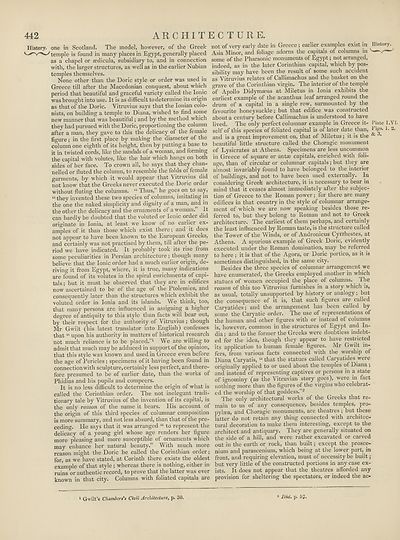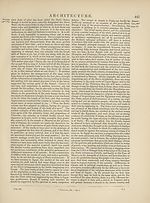Encyclopaedia Britannica > Volume 3, Anatomy-Astronomy
(450) Page 442
Download files
Complete book:
Individual page:
Thumbnail gallery: Grid view | List view

442 ARCHITECTUR E.
History, one in Scotland. The model, however, of the Greek
temple is found in many places in Egypt, generally placed
as a chapel or aedicula, subsidiary to, and in connection
with, the larger structures, as well as in the earlier Nubian
temples themselves.
None other than the Doric style or order was used in
Greece till after the Macedonian conquest, about which
period that beautiful and graceful variety called the Ionic
was brought into use. It is as difficult to determine its origin
as that of the Doric. Vitruvius says that the Ionian colo¬
nists, on building a temple to Diana, wished to find some
new manner that was beautiful; and by the method which
they had pursued with the Doric, proportioning the column
after a man, they gave to this the delicacy of the female
figure; in the first place by making the diameter of the
column one eighth of its height, then by putting a base^ to
it in twisted cords, like the sandals of a woman, and foiming
the capital with volutes, like the hair which hangs on both
sides of her face. To crown all, he says that they chan¬
nelled or fluted the column, to resemble the folds of female
garments, by which it would appear that Vitruvius did
not know that the Greeks never executed the Doric order
without fluting the columns. “ Thus,” he goes on to say,
“ they invented these two species of columns, imitating in
the one the naked simplicity and dignity of a man, and in
the other the delicacy and the ornaments of a woman.” It
can hardly be doubted that the voluted or Ionic order did
originate in Ionia, at least we know of no earlier ex¬
amples of it than those which exist there; and it does
not appear to have been known to the European Greeks,
and certainly was not practised by them, till after the pe¬
riod we have indicated. It probably took its rise from
some peculiarities in Persian architecture; though many
believe that the Ionic order had a much earlier origin, de¬
riving it from Egypt, where, it is true, many indications
are found of its volutes in the spiral enrichments of capi¬
tals ; but it must be observed that they are in edifices
now ascertained to be of the age of the Ptolemies, and
consequently later than the structures which exhibit the
voluted order in Ionia and its islands. We think, too,
that many persons are influenced in assigning a higher
degree of antiquity to this style than facts will bear out,
by their respect for the authority of Vitruvius; though
Mr Gwilt (his latest translator into English) confesses
that “ upon his authority in matters of historical research
not much reliance is to be placed.”1 We are willing to
admit that much may be adduced in support of the opinion,
that this style was known and used in Greece even before
the age of Pericles ; specimens of it having been found in
connection with sculpture, certainly less perfect, and there¬
fore presumed to be of earlier date, than the works of
Phidias and his pupils and compeers.
It is no less difficult to determine the origin of what is
called the Corinthian order. The not inelegant tradi¬
tionary tale by Vitruvius of the invention of its capital, is
the only reason of the name it bears. His account of
the origin of this third species of columnar composition
is more summary, and not less absurd, than that of the pre¬
ceding. He says that it was arranged “ to represent the
delicacy of a young girl whose age renders her figure
more pleasing and more susceptible of ornaments which
may enhance her natural beauty.” With much more
reason might the Doric be called the Corinthian order;
for, as we have stated, at Corinth there exists the oldest
example of that style ; whereas there is nothing, either in
ruins or authentic record, to prove that the latter was ever
known in that city. Columns with foliated capitals are
not of very early date in Greece ; earlier examples exist in History.
Asia Minor, and foliage adorns the capitals of columns in /
some of the Pharaonic monuments of Egypt; not arranged,
indeed, as in the later Corinthian capital, which by pos¬
sibility may have been the result of some such accident
as Vitruvius relates of Callimachus and the basket on the
grave of the Corinthian virgin. The interior of the temple
of Apollo Didymaeus at Miletus in Ionia exhibits the
earliest example of the acanthus leaf arranged round the
drum of a capital in a single row, surmounted by the
favourite honeysuckle; but that edifice was constructed
about a century before Callimachus is understood to have
lived. The only perfect columnar example in Greece it- Plate I.VI.
self of this species of foliated capital is of later date than, Cigs. 1, 2,
and is a great improvement on, that of Miletus; it is the
beautifur little structure called the Choragic monument
of Lysicrates at Athens. Specimens are less uncommon
in Greece of square or antae capitals, enriched with foli¬
age, than of circular or columnar capitals; but they are
almost invariably found to have belonged to the interior
of buildings, and not to have been used externally. In
considering Greek architecture, it is necessary to bear in
mind that it ceases almost immediately after the subjec¬
tion of Greece to the Roman power; for there are many
edifices in that country in the style of columnar arrange¬
ment of which we are now speaking besides those re¬
ferred to, but they belong to Roman and not to Greek
architecture. The earliest of them perhaps, and certainly
the least influenced by Roman taste, is the structure called
the Tower of the Winds, or of Andronicus Cyrrhestes, at
Athens. A spurious example of Greek Doric, evidently
executed under the Roman domination, may be referred
to here ; it is that of the Agora, or Doric portico, as it is
sometimes distinguished, in the same city.
Besides the three species of columnar arrangement we
have enumerated, the Greeks employed another in which
statues of women occupied the place of columns. I he
reason of this too Vitruvius furnishes in a story which is,
as usual, totally unsupported by history or analogy; but
the consequence of it is, that such figures are called
Caryatides; and the arrangement has been called by
some the Caryatic order. The use of representations of
the human and other figures with or instead of columns
is, however, common in the structures of Egypt and In¬
dia ; and to the former the Greeks were doubtless indebt¬
ed for the idea, though they appear to have restricted
its application to human female figures. Mr Gwilt in¬
fers, from various facts connected with the worship of
Diana Caryatis, “ that the statues called Caryatides were
originally applied to or used about the temples of Diana;
and instead of representing captives or persons in a state
of ignominy (as the Vitruvian story goes), were in fact
nothing more than the figures of the virgins who celebrat¬
ed the worship of that goddess.”2
The only architectural works of the Greeks that re¬
main to us of any consequence, besides temples, pro-
pvla^, and Choragic monuments, are theaties ; but these
latter do not retain any thing connected with architec¬
tural decoration to make them interesting, except to the
architect and antiquary. They are generally situated on
the side of a hill, and were rather excavated or carved
out in the earth or rock, than built; except the prosce¬
nium and parascenium, which being at the lower part, in
front, and requiring elevation, must of necessity be built;
but very little of the constructed portions in any case ex¬
ists. It does not appear that the theatres afforded any
provision for sheltering the spectators, or indeed the ac-
1 Gwilt’s Chambers's Civil Architecture, p. 30.
2 Ibid. p. 57.
History, one in Scotland. The model, however, of the Greek
temple is found in many places in Egypt, generally placed
as a chapel or aedicula, subsidiary to, and in connection
with, the larger structures, as well as in the earlier Nubian
temples themselves.
None other than the Doric style or order was used in
Greece till after the Macedonian conquest, about which
period that beautiful and graceful variety called the Ionic
was brought into use. It is as difficult to determine its origin
as that of the Doric. Vitruvius says that the Ionian colo¬
nists, on building a temple to Diana, wished to find some
new manner that was beautiful; and by the method which
they had pursued with the Doric, proportioning the column
after a man, they gave to this the delicacy of the female
figure; in the first place by making the diameter of the
column one eighth of its height, then by putting a base^ to
it in twisted cords, like the sandals of a woman, and foiming
the capital with volutes, like the hair which hangs on both
sides of her face. To crown all, he says that they chan¬
nelled or fluted the column, to resemble the folds of female
garments, by which it would appear that Vitruvius did
not know that the Greeks never executed the Doric order
without fluting the columns. “ Thus,” he goes on to say,
“ they invented these two species of columns, imitating in
the one the naked simplicity and dignity of a man, and in
the other the delicacy and the ornaments of a woman.” It
can hardly be doubted that the voluted or Ionic order did
originate in Ionia, at least we know of no earlier ex¬
amples of it than those which exist there; and it does
not appear to have been known to the European Greeks,
and certainly was not practised by them, till after the pe¬
riod we have indicated. It probably took its rise from
some peculiarities in Persian architecture; though many
believe that the Ionic order had a much earlier origin, de¬
riving it from Egypt, where, it is true, many indications
are found of its volutes in the spiral enrichments of capi¬
tals ; but it must be observed that they are in edifices
now ascertained to be of the age of the Ptolemies, and
consequently later than the structures which exhibit the
voluted order in Ionia and its islands. We think, too,
that many persons are influenced in assigning a higher
degree of antiquity to this style than facts will bear out,
by their respect for the authority of Vitruvius; though
Mr Gwilt (his latest translator into English) confesses
that “ upon his authority in matters of historical research
not much reliance is to be placed.”1 We are willing to
admit that much may be adduced in support of the opinion,
that this style was known and used in Greece even before
the age of Pericles ; specimens of it having been found in
connection with sculpture, certainly less perfect, and there¬
fore presumed to be of earlier date, than the works of
Phidias and his pupils and compeers.
It is no less difficult to determine the origin of what is
called the Corinthian order. The not inelegant tradi¬
tionary tale by Vitruvius of the invention of its capital, is
the only reason of the name it bears. His account of
the origin of this third species of columnar composition
is more summary, and not less absurd, than that of the pre¬
ceding. He says that it was arranged “ to represent the
delicacy of a young girl whose age renders her figure
more pleasing and more susceptible of ornaments which
may enhance her natural beauty.” With much more
reason might the Doric be called the Corinthian order;
for, as we have stated, at Corinth there exists the oldest
example of that style ; whereas there is nothing, either in
ruins or authentic record, to prove that the latter was ever
known in that city. Columns with foliated capitals are
not of very early date in Greece ; earlier examples exist in History.
Asia Minor, and foliage adorns the capitals of columns in /
some of the Pharaonic monuments of Egypt; not arranged,
indeed, as in the later Corinthian capital, which by pos¬
sibility may have been the result of some such accident
as Vitruvius relates of Callimachus and the basket on the
grave of the Corinthian virgin. The interior of the temple
of Apollo Didymaeus at Miletus in Ionia exhibits the
earliest example of the acanthus leaf arranged round the
drum of a capital in a single row, surmounted by the
favourite honeysuckle; but that edifice was constructed
about a century before Callimachus is understood to have
lived. The only perfect columnar example in Greece it- Plate I.VI.
self of this species of foliated capital is of later date than, Cigs. 1, 2,
and is a great improvement on, that of Miletus; it is the
beautifur little structure called the Choragic monument
of Lysicrates at Athens. Specimens are less uncommon
in Greece of square or antae capitals, enriched with foli¬
age, than of circular or columnar capitals; but they are
almost invariably found to have belonged to the interior
of buildings, and not to have been used externally. In
considering Greek architecture, it is necessary to bear in
mind that it ceases almost immediately after the subjec¬
tion of Greece to the Roman power; for there are many
edifices in that country in the style of columnar arrange¬
ment of which we are now speaking besides those re¬
ferred to, but they belong to Roman and not to Greek
architecture. The earliest of them perhaps, and certainly
the least influenced by Roman taste, is the structure called
the Tower of the Winds, or of Andronicus Cyrrhestes, at
Athens. A spurious example of Greek Doric, evidently
executed under the Roman domination, may be referred
to here ; it is that of the Agora, or Doric portico, as it is
sometimes distinguished, in the same city.
Besides the three species of columnar arrangement we
have enumerated, the Greeks employed another in which
statues of women occupied the place of columns. I he
reason of this too Vitruvius furnishes in a story which is,
as usual, totally unsupported by history or analogy; but
the consequence of it is, that such figures are called
Caryatides; and the arrangement has been called by
some the Caryatic order. The use of representations of
the human and other figures with or instead of columns
is, however, common in the structures of Egypt and In¬
dia ; and to the former the Greeks were doubtless indebt¬
ed for the idea, though they appear to have restricted
its application to human female figures. Mr Gwilt in¬
fers, from various facts connected with the worship of
Diana Caryatis, “ that the statues called Caryatides were
originally applied to or used about the temples of Diana;
and instead of representing captives or persons in a state
of ignominy (as the Vitruvian story goes), were in fact
nothing more than the figures of the virgins who celebrat¬
ed the worship of that goddess.”2
The only architectural works of the Greeks that re¬
main to us of any consequence, besides temples, pro-
pvla^, and Choragic monuments, are theaties ; but these
latter do not retain any thing connected with architec¬
tural decoration to make them interesting, except to the
architect and antiquary. They are generally situated on
the side of a hill, and were rather excavated or carved
out in the earth or rock, than built; except the prosce¬
nium and parascenium, which being at the lower part, in
front, and requiring elevation, must of necessity be built;
but very little of the constructed portions in any case ex¬
ists. It does not appear that the theatres afforded any
provision for sheltering the spectators, or indeed the ac-
1 Gwilt’s Chambers's Civil Architecture, p. 30.
2 Ibid. p. 57.
Set display mode to:
![]() Universal Viewer |
Universal Viewer | ![]() Mirador |
Large image | Transcription
Mirador |
Large image | Transcription
Images and transcriptions on this page, including medium image downloads, may be used under the Creative Commons Attribution 4.0 International Licence unless otherwise stated. ![]()
| Encyclopaedia Britannica > Encyclopaedia Britannica > Volume 3, Anatomy-Astronomy > (450) Page 442 |
|---|
| Permanent URL | https://digital.nls.uk/193763198 |
|---|
| Attribution and copyright: |
|
|---|---|
| Shelfmark | EB.16 |
|---|---|
| Description | Ten editions of 'Encyclopaedia Britannica', issued from 1768-1903, in 231 volumes. Originally issued in 100 weekly parts (3 volumes) between 1768 and 1771 by publishers: Colin Macfarquhar and Andrew Bell (Edinburgh); editor: William Smellie: engraver: Andrew Bell. Expanded editions in the 19th century featured more volumes and contributions from leading experts in their fields. Managed and published in Edinburgh up to the 9th edition (25 volumes, from 1875-1889); the 10th edition (1902-1903) re-issued the 9th edition, with 11 supplementary volumes. |
|---|---|
| Additional NLS resources: |
|

